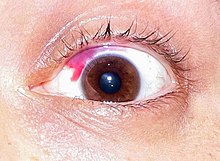| Revision as of 16:44, 18 August 2007 edit70.127.33.18 (talk) →Causes← Previous edit | Revision as of 14:00, 24 September 2007 edit undo203.76.197.178 (talk) →CausesNext edit → | ||
| Line 12: | Line 12: | ||
| Although its appearance may be alarming, a subconjunctival hemorrhage is generally a painless and harmless condition; however, it may be associated with ], or ] to the ]. | Although its appearance may be alarming, a subconjunctival hemorrhage is generally a painless and harmless condition; however, it may be associated with ], or ] to the ]. | ||
| ==Causes== | '''Bold text'''==Causes== | ||
| *Minor eye trauma | *Minor eye trauma | ||
| *Spontaneously with increased venous pressure | *Spontaneously with increased venous pressure | ||
Revision as of 14:00, 24 September 2007
Medical condition| Subconjunctival bleeding | |
|---|---|
| Specialty | Ophthalmology |

A subconjunctival hemorrhage (or subconjunctival haemorrhage) is bleeding underneath the conjunctiva. The conjunctiva contains many small, fragile blood vessels that are easily ruptured or broken. When this happens, blood leaks into the space between the conjunctiva and sclera.
Whereas a bruise typically appears black or blue underneath the skin, a subconjunctival hemorrhage initially appears bright red underneath the transparent conjunctiva. Later the hemorrhage may spread and become green or yellow, like a bruise. Usually this disappears within 2 weeks.
Although its appearance may be alarming, a subconjunctival hemorrhage is generally a painless and harmless condition; however, it may be associated with high blood pressure, or trauma to the eye.
Bold text==Causes==
- Minor eye trauma
- Spontaneously with increased venous pressure
- Strenuous Exercising
- Coughing
- Touching/widening eyes
- Sneezing
- Pulling extreme g-forces
- Vomiting, particularly forced vomiting as seen in bulimia nervosa
- Straining
- Severe alcohol intoxication, leading to raised blood pressure
- Blood dyscrasia (rare)
- Severe hypertension
- LASIK
- Blood thinners, such as ginger, capsaicin, ginseng, garlic, aspirin, or Herba if taken in high doses or combined. These can also make the vessels in the eye more susceptible to the pressure causes listed above.
Subconjunctival hemorrhages in infants may be associated with scurvy (a vitamin C deficiency),, abuse or traumatic asphyxia syndrome .
Treatment and management
A subconjunctival hemorrhage is typically a self-limiting condition that requires no treatment in the absence of infection or significant trauma. The elective use of aspirin and NSAIDs is typically discouraged.
A common symptom of a subconjunctival hemorrhage, itchy eyes, is often treated by applying eye drops or artificial tears to the affected eye(s), however, this is discouraged, as it may slow down the healing time.